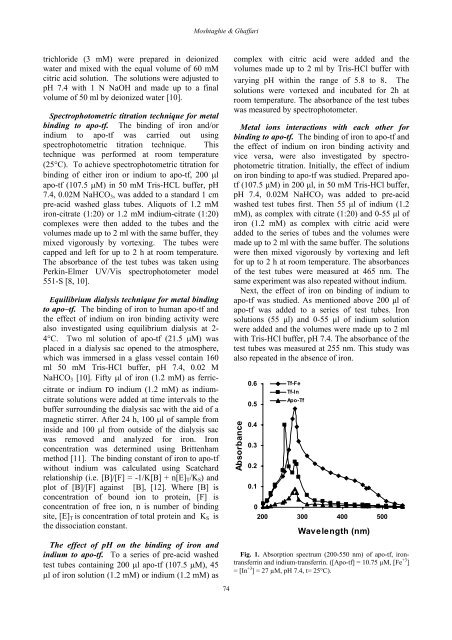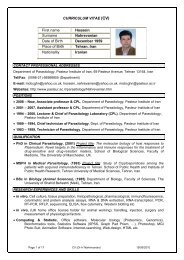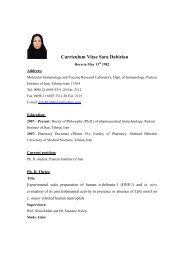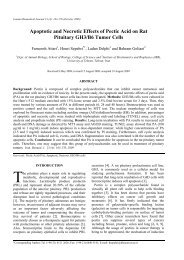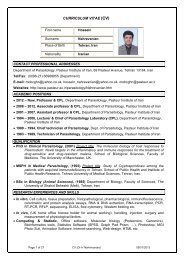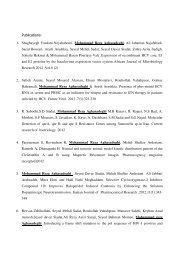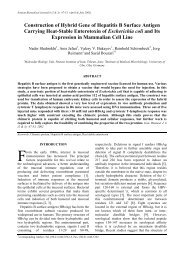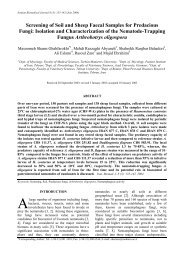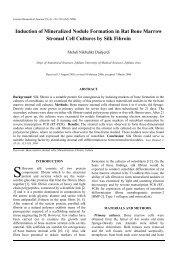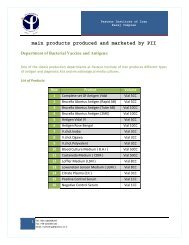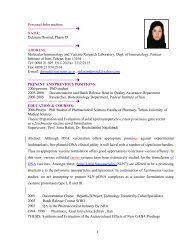Study of the Binding of Iron and Indium to Human Serum Apo ...
Study of the Binding of Iron and Indium to Human Serum Apo ...
Study of the Binding of Iron and Indium to Human Serum Apo ...
Create successful ePaper yourself
Turn your PDF publications into a flip-book with our unique Google optimized e-Paper software.
Moshtaghie & Ghaffaritrichloride (3 mM) were prepared in deionizedwater <strong>and</strong> mixed with <strong>the</strong> equal volume <strong>of</strong> 60 mMcitric acid solution. The solutions were adjusted <strong>to</strong>pH 7.4 with 1 N NaOH <strong>and</strong> made up <strong>to</strong> a finalvolume <strong>of</strong> 50 ml by deionized water [10].Spectropho<strong>to</strong>metric titration technique for metalbinding <strong>to</strong> apo-tf. The binding <strong>of</strong> iron <strong>and</strong>/orindium <strong>to</strong> apo-tf was carried out usingspectropho<strong>to</strong>metric titration technique. Thistechnique was performed at room temperature(25°C). To achieve spectropho<strong>to</strong>metric titration forbinding <strong>of</strong> ei<strong>the</strong>r iron or indium <strong>to</strong> apo-tf, 200 µlapo-tf (107.5 µM) in 50 mM Tris-HCL buffer, pH7.4, 0.02M NaHCO 3 , was added <strong>to</strong> a st<strong>and</strong>ard 1 cmpre-acid washed glass tubes. Aliquots <strong>of</strong> 1.2 mMiron-citrate (1:20) or 1.2 mM indium-citrate (1:20)complexes were <strong>the</strong>n added <strong>to</strong> <strong>the</strong> tubes <strong>and</strong> <strong>the</strong>volumes made up <strong>to</strong> 2 ml with <strong>the</strong> same buffer, <strong>the</strong>ymixed vigorously by vortexing. The tubes werecapped <strong>and</strong> left for up <strong>to</strong> 2 h at room temperature.The absorbance <strong>of</strong> <strong>the</strong> test tubes was taken usingPerkin-Elmer UV/Vis spectropho<strong>to</strong>meter model551-S [8, 10].Equilibrium dialysis technique for metal binding<strong>to</strong> apo–tf. The binding <strong>of</strong> iron <strong>to</strong> human apo-tf <strong>and</strong><strong>the</strong> effect <strong>of</strong> indium on iron binding activity werealso investigated using equilibrium dialysis at 2-4°C. Two ml solution <strong>of</strong> apo-tf (21.5 µM) wasplaced in a dialysis sac opened <strong>to</strong> <strong>the</strong> atmosphere,which was immersed in a glass vessel contain 160ml 50 mM Tris-HCl buffer, pH 7.4, 0.02 MNaHCO 3 [10]. Fifty µl <strong>of</strong> iron (1.2 mM) as ferriccitrateor indium r o indium (1.2 mM) as indiumcitratesolutions were added at time intervals <strong>to</strong> <strong>the</strong>buffer surrounding <strong>the</strong> dialysis sac with <strong>the</strong> aid <strong>of</strong> amagnetic stirrer. After 24 h, 100 µl <strong>of</strong> sample frominside <strong>and</strong> 100 µl from outside <strong>of</strong> <strong>the</strong> dialysis sacwas removed <strong>and</strong> analyzed for iron. <strong>Iron</strong>concentration was determined using Brittenhammethod [11]. The binding constant <strong>of</strong> iron <strong>to</strong> apo-tfwithout indium was calculated using Scatchardrelationship (i.e. [B]/[F] = -1/K[B] + n[E] T /K S ) <strong>and</strong>plot <strong>of</strong> [B]/[F] against [B], [12]. Where [B] isconcentration <strong>of</strong> bound ion <strong>to</strong> protein, [F] isconcentration <strong>of</strong> free ion, n is number <strong>of</strong> bindingsite, [E] T is concentration <strong>of</strong> <strong>to</strong>tal protein <strong>and</strong> K S is<strong>the</strong> dissociation constant.The effect <strong>of</strong> pH on <strong>the</strong> binding <strong>of</strong> iron <strong>and</strong>indium <strong>to</strong> apo-tf. To a series <strong>of</strong> pre-acid washedtest tubes containing 200 µl apo-tf (107.5 µM), 45µl <strong>of</strong> iron solution (1.2 mM) or indium (1.2 mM) as74complex with citric acid were added <strong>and</strong> <strong>the</strong>volumes made up <strong>to</strong> 2 ml by Tris-HCl buffer withvarying pH within <strong>the</strong> range <strong>of</strong> 5.8 <strong>to</strong> 8. Thesolutions were vortexed <strong>and</strong> incubated for 2h atroom temperature. The absorbance <strong>of</strong> <strong>the</strong> test tubeswas measured by spectropho<strong>to</strong>meter.Metal ions interactions with each o<strong>the</strong>r forbinding <strong>to</strong> apo-tf. The binding <strong>of</strong> iron <strong>to</strong> apo-tf <strong>and</strong><strong>the</strong> effect <strong>of</strong> indium on iron binding activity <strong>and</strong>vice versa, were also investigated by spectropho<strong>to</strong>metrictitration. Initially, <strong>the</strong> effect <strong>of</strong> indiumon iron binding <strong>to</strong> apo-tf was studied. Prepared apotf(107.5 µM) in 200 µl, in 50 mM Tris-HCl buffer,pH 7.4, 0.02M NaHCO 3 was added <strong>to</strong> pre-acidwashed test tubes first. Then 55 µl <strong>of</strong> indium (1.2mM), as complex with citrate (1:20) <strong>and</strong> 0-55 µl <strong>of</strong>iron (1.2 mM) as complex with citric acid wereadded <strong>to</strong> <strong>the</strong> series <strong>of</strong> tubes <strong>and</strong> <strong>the</strong> volumes weremade up <strong>to</strong> 2 ml with <strong>the</strong> same buffer. The solutionswere <strong>the</strong>n mixed vigorously by vortexing <strong>and</strong> leftfor up <strong>to</strong> 2 h at room temperature. The absorbances<strong>of</strong> <strong>the</strong> test tubes were measured at 465 nm. Thesame experiment was also repeated without indium.Next, <strong>the</strong> effect <strong>of</strong> iron on binding <strong>of</strong> indium <strong>to</strong>apo-tf was studied. As mentioned above 200 µl <strong>of</strong>apo-tf was added <strong>to</strong> a series <strong>of</strong> test tubes. <strong>Iron</strong>solutions (55 µl) <strong>and</strong> 0-55 µl <strong>of</strong> indium solutionwere added <strong>and</strong> <strong>the</strong> volumes were made up <strong>to</strong> 2 mlwith Tris-HCl buffer, pH 7.4. The absorbance <strong>of</strong> <strong>the</strong>test tubes was measured at 255 nm. This study wasalso repeated in <strong>the</strong> absence <strong>of</strong> iron.Absorbance0.60.50.40.30.20.10Tf-FeTf-InAp o -Tf200 300 400 500Wavelength (nm)Fig. 1. Absorption spectrum (200-550 nm) <strong>of</strong> apo-tf, irontransferrin<strong>and</strong> indium-transferrin. ([<strong>Apo</strong>-tf] = 10.75 µM, [Fe +3 ]= [In +3 ] = 27 µM, pH 7.4, t= 25°C).


